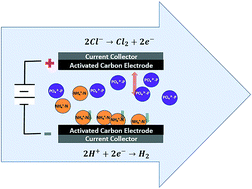Capacitive deionization for nutrient recovery from wastewater with disinfection capability†
Abstract
This study demonstrates that capacitive deionization can be effectively used for the removal and recovery of dominant nitrogen (ammonium) and phosphorus (phosphate salts) species present in wastewater. Moreover, low concentrations of chlorine and other oxidants can be generated in situ for disinfection. With an applied voltage from 1.2 V to 3.0 V, salts, ammonium, and phosphorus can be quickly removed from water and adsorbed on the electrodes due to the formation of an electrical double layer, and results show that the removal efficiency was 77.5–91.2% for salts, 60.5–95.7% for ammonium, and 46.4–80.7% for phosphorus, respectively. In addition, most of the adsorbed ions are released back to the concentrate during regeneration, so high nutrient recovery can be accomplished as well. Such a simple electrochemical process can be promising to solve both nutrient and salinity problems after biological treatments for discharge and reuse, and the additional disinfection function adds further benefits to improve water quality and safety with low cost.

- This article is part of the themed collection: Best Papers 2018 – Environmental Science: Water Research & Technology


 Please wait while we load your content...
Please wait while we load your content...